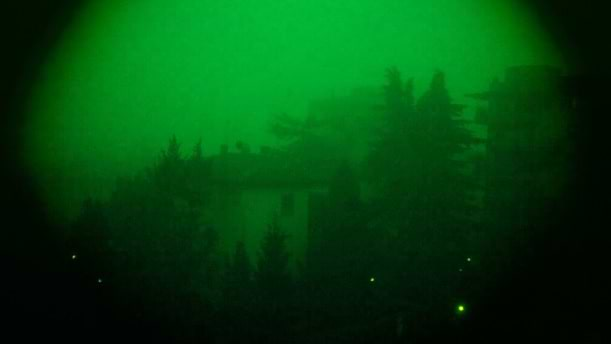
A lot of the world’s leading drone manufacturers are partnering with various infrared and thermal imaging companies to create cameras that can be attached to drones.
There are currently no drones that have built-in night vision that being said, here’s a list of drones I found that can be paired with night vision cameras.
| Drone Name: | Flight Time: | Video Quality: | Range: | Price: | Purchase Link: | |
| 01. | Yuneec Typhoon H | 25 min | 4K | 1 mile | $1,199 | VIEW |
| 02. | Mavic 2 Enterprise | 31 min | 4K | 5 miles | $1,599 | VIEW |
| 03. | Matrice 200 | 35 min | 4K | 4.3 miles | $5,500 | VIEW |
| 04. | Inspire 1 | 22 min | 4K | 1.2 miles | $1,300 | VIEW |
| 05. | Matrice 210 V2 | 38 min | 4K | 5 miles | $6,000 | VIEW |
Keep reading for an in-depth look at each one of these drones and a look at other geothermal cameras that make it possible for drones to see at night.
01. Yuneec Typhoon H
The Yuneec Typhoon H is one of the most advanced aerial photography and videography drones on the market. The Typhoon H was designed to deliver capabilities that were only found in high-end drones but now at a consumer price.
Built-in camera. The drone comes with a 3-axis anti-vibration CGO3+ gimbal camera that is able to capture ultra-stable 4K Ultra High Definition video. It can also take brilliant 12-megapixel images.
What’s special about this gimbal is that it is able to rotate 360 degrees, therefore allowing for an amazing range of motion for a great video!
Thermal camera to be paired with. The Yuneec Typhoon H can be paired with the YUNCGOETUS otherwise known as the Yuneec CGOET camera which is an innovative combination of thermal imaging and a low light camera.
The thermal imaging camera selectively measures the temperature in the image and indicates the relative temperature differences. It makes a great pairing for the Typhoon H as it fits nicely on the 3-axis gimbal, allowing for 360-degree rotation and thermal imaging.
02. Mavic 2 Enterprise
The Mavic 2 was a long-awaited upgrade to the Mavic series of drones. It is currently one of the leading drones in its category with its amazing sensors and flight time, putting it far ahead of the rest.
Flight Time. With a flight time of 31 minutes and a range of 11 miles, you can be sure that you will have amazing experiences with this drone.
Sensors. The Mavic 2 has a 1-inch sensor that offers better image quality with superior light and color performance than ever before.
Built-in camera.DJI worked together with Hasselblad in order to fit a unique camera to this drone with magnificent 20-megapixel quality. This new and improved camera lets you take detailed aerial photos.
Thermal Camera: DJI has a series called the Enterprise series that was designed to serve those in the video and photography industry who expect just a little more from the drones they use.
The Enterprise Dual allows for visible and thermal imagery. The drone’s camera has an integrated radiometric FLIR thermal sensor.
It also has multiple display modes which include:
- FLIR MSX
- Infrared
- Visible
03. Matrice 200
The DJI Matrice 200 was made by DJI to endure whatever conditions are thrown at it and engineered to adapt to them.
Flight Time: The Matrice has a remarkable flight time of 38 minutes and a range of 4.4 miles which makes for great exploration with this drone. The 38 minute flight time is possible because of its dual battery system which allows it to double the would-be flight time if it only had one battery.
Camera: The Matrice drones are able to be paired with a lot of different cameras from the Zenmuse camera range offered by DJI.
These cameras include:
- ZENMUSE XT2
- ZENMUSE Z30
- ZENMUSE X4S
- ZENMUSE X5S
All these cameras are amazing and offer exactly what anyone in the industry might be looking for in a camera on a drone.
Thermal Camera: The Zenmuse camera that can be fitted onto the Matrice 200 that offers thermal/infrared modes is the ZENMUSE XT2.
This camera has the option of infrared and 4K combined, with an infrared frame rate of 9Hz or 30Hz. It also has a dual-sensor with 4K visual and thermal.
04. Inspire 1
With the DJI Inspire 1, DJI’s most advanced technology comes together in order to help you create amazing visuals while using one flying platform.
Design: The Inspire 1 has carbon fiber arms that are strong enough to handle the air and are able to transform in order to move out of the camera’s way at just one flip of a switch.
Thermal camera: You can link the Inspire 1 with the Zenmuse XT which is a thermal imaging camera.
This camera is possible by combining DJI’s unmatched expertise in gimbal technology and FLIR’s leading image transmission and thermal imaging.
With this camera you are able to capture images faster with pinpoint precision over large areas, then save them for analysis and reporting.
05. Matrice 210 V2
The Matrice 210 V2 is a step up from the Matrice 200 and it also has unique obstacle avoidance features.
Flight Time: This is the improved version of the Matrice 200, so it boasts a flight time of 38 mins which is not a lot longer than the 200. However, any extra minutes can mean a lot for videographers and photographers.
Unique Features: The 210 also has IP43 waterproofing, which allows it to fly in heavy rain and high winds.
Camera Options: There are many options for different gimbals and cameras that are available for the M210. The gimbals can be mounted in 3 different ways.
- Single downward facing
- Dual downward facing
- Upward facing
These options allow for easily interchangeable camera equipment and it makes it a lot easier for the pilot to change cameras in order to suit the situation or environment they are in.
Thermal Camera: The camera that is able to be paired with the Matrice 210 is the Zenmuse XT2. This is the next generation of dual-camera solutions for commercial drones.
It has a 12MP visual sensor and a 30 Hz maximum thermal frame rate. The camera can be implemented in different industries such as agriculture, fire fighting and search and rescue operations.
What Can Thermal Cameras Capture?
Thermal energy is radiating off of every single living organism on this planet. Thermal cameras are really just in fact heat-detecting cameras and they are known by many different names:
- Thermal Camera
- Thermal Vision Camera
- Thermal Imaging Camera
- Thermal Heat Vision Sensor
- Heat Vision Camera
- Heat Signature Camera
- Thermal Imaging Sensor
- Heat Sensor Camera
- Temperature Sensor Camera
Heat vision cameras can capture a variety of different images and the differences in heat emitted by:
- Living Organisms
- Machines
- Electrical circuits, powerlines etc.
- Terain
- Liquids and Gases
Different objects absorb and radiate heat signatures at different levels and rates so no two objects will have the same heat signature at one time. That is how heat vision cameras are able to see at night and become a type of night vision for people and machines.
Final Thoughts
Thermal cameras are amazing machines and are perfect additions to the droning world as there are so many applications for them.
Drones can be used in firefighting and rescue operations to locate people who might be trapped in a building or a forest engulfed in flames. Drones are also able to fly into dangerous areas to help with surveying an area without endangering the lives of many firefighters or volunteers.
They can also be used for surveillance in police stakeouts so cops can see into buildings without needing to be inside the buildings. Drones come in handy at these times especially at times when the buildings are high and they need to get the thermal camera into the sky.
Thermal cameras are surely just at the beginning of their integration into the droning world and we should see a lot more of them in the future, so watch this space for more information!
